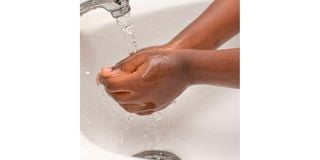Premium
Sixty years on, more than half of Kenyans do not have access to clean water; what happened?

While strides have been made to increase access to safe water, 60 years since independence is a long time to have only 34 per cent of the population benefit from such a necessity.
They say water is life. But, when the available water is a threat to a healthy life, then by extension, it impedes the existence of a whole society.
In the country, latest data from the 2019 Kenya Population and Housing Census shows that less than half of Kenyans have access to clean (others call it piped) water.
While strides have been made to increase access to safe water, 60 years since independence is a relatively long time to have only 34 per cent of the population benefit from such a necessity.
Globally, there is an abstract North Star that people are working towards to help in ensuring lives and livelihoods remain wholesome. These are the United Nations Sustainable Development Goals. Clean water and sanitation is the sixth of the seventeen goals.
In the country, a replica to the SDGs is Kenya's Vision 2030 whose imprints show a visionary country whose citizens should access clean water.
However, there are impediments to this realisation. This is despite there being a provision in our new constitution that calls for the government to ensure all Kenyans have clean and safe water, and in adequate quantities.
With all these polished plans and regulations, at least on paper, the gap between those who access clean water, and those who don’t is growing.
Why then is the piping dream still a pipe dream?
In 1963, there were about nine million people living in Kenya. At the time, there was plenty of water and most natural sources had not been interfered with by human activities. Kenya had just gained independence, and its development status was still below par.
Today, there are more than 50 million Kenyans whose land and resources are still the same and have to be distributed equally. We are on track to development owing to our low and middle income status.
The country has five main water towers, which include; Mt Elgon, Cherangani Hills, Mau Forest Complex, Aberdare Ranges and Mt. Kenya.
Studies show that these natural water sources are not enough for the population.
“Kenyans are consuming about 33 billion cubic metres, of which their total renewable water resources only amount to 30.7 billion cubic metres, this results in a difference of 2.7 cubic metres,” says a study published in the journal Scientific Research.
Kenya’s largest forest, Mau, for instance, distributes water to six lakes and about eight wildlife reserves.
About 10 million people (and counting) also depend on the more than 10 rivers that feed from it, for their livelihood. However, deforestation, in the name of logging, affected a huge chunk of the forest.
“The sizes of dense forest and lakes have been declining significantly from 1984 to 2015. This is from the fact that there has been a lot of illegal cutting down of trees and clearing of land for cultivation within. As a result, the impact of depleting forests has negatively impacted on various lakes that draw their water from Mau forest and the surrounding as a whole,” explains a study published in the scientific journal Hydrology current research.
Giving an example of Lake Nakuru’s shrinking size, the researchers link it to the activities of the Mau forest.
“When forest cover bonding the soil in a lake basin is destroyed, the result is usually an increase in land erosion and sediment transport, which in turn leads to reduced lake water quality which limits the penetration of light into the water column. Deforestation would therefore decrease natural seepage into underground aquifers, leading to accelerated surface runoff causing siltation in the lake,” explains the researchers.
The once dense canopy of the Mau is now sparse. This then means that there are fewer trees to help in taking in carbon dioxide which is one of the greenhouse gases that if emitted for a long period of time, can result in climate change.
Climate change in turn births extreme conditions like drying of rivers, drought, among others, which affects the availability of water.
The country has recently had the worst drought experienced in four decades coupled with depressed rainfall patterns in different parts of Kenya.
A progress report of the Vision 2030 for the year 2020 and 2021 shows that depressed rainfall, especially during short rains led to water scarcity which they say ‘interfered with the implementation of some projects’.
“Water management has been a major challenge in Kenya across the decades. However, water scarcity has led to poor sanitation and poor hygiene collectively posing substantial health risks, particularly in low-income regions and eventually contributing to the emergence of some diseases,” explains a study published in the Scientific Research journal dubbed SCIRP.
“Water shortage in Kenya is largely pronounced in rural areas and largely in the Arid and Semi-Arid Lands (ASALs) which has led to the strain on women and children having the task of searching for water especially for domestic use,” they add.
Some people may not get clean water in this age because that which is available to them is polluted. About 80 per cent of water pollution comes from industries and agriculture.
“Water pollution has affected water quality due to various pollutants such as chemical, microbiological, thermal pollutants,” they say.
“Some industrial and the county government’s sewage plants may release partially treated or completely untreated effluents into the surface water sources containing high levels of toxic substances. As a result, this affects most people living in the urban informal settlements due to lack of access to clean water hence causing disease outbreaks affecting their health and livelihoods,” adds the study.
All hope is not lost as the SCIRP study recommends that since there is knowledge that there is water demand in a burgeoning population, planning should be essential.
“Kenya can boost its water productivity in a short-term period by harmonising and strengthening the existing and established multi-level water management bodies such as the Catchment Area Advisory Committees, Water Users Associations and Water Resource Management Authority,” they suggest.
“The adoption of advanced technological solutions and practices that improve water use efficiency by users should be a primary goal for water management to reduce water loss, support the sustainability of water resources, and increase the economic profitability of water,” they add.




